Sefer Midrash Rabbot
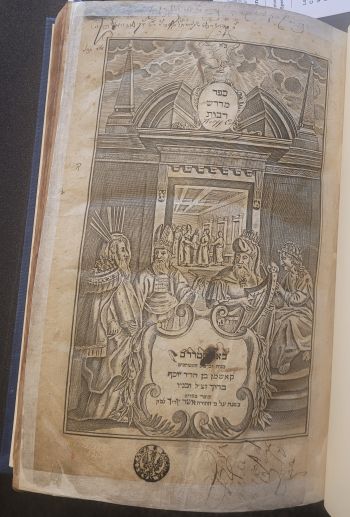
Sefer Midrash Rabbot was printed in 1777 in Amsterdam in the printing house of Kashman Ben Yosef Barukh and sons. This work contains the Midrash, Jewish Rabbinic Exegesis, on the five books of the Torah, along with the five Megillot. It includes Rabbinic approbations from prominent rabbinic luminaries of the time, along with many commentaries on the Midrash. The copy housed in Kislak has a rich circulation history, with indications that it was reviewed by Polish censors, and owned by Wolf Cohen and Rabbi Marcus Jastrow before it was donated to Penn.
Literary Work Information
Origin of the main text
According to Jewish Tradition, the written Torah was given to the Jews by God after their exodus from Egypt around the year 1313 BCE.[1] In tandem, an Oral Torah was given that has been expanded with each generation to this day.[2] One aspect of this Oral Torah is called Midrash, which encompasses a broad range of commentary based on the Torah, containing stories, legal ideas, moral and ethical teachings and more. Of the Midrash, Midrash Rabbah came to be the most widely printed, consisting of 10 separate works on the five books of Moses and the five megillot. The 10 works were first printed together in the 16th century.[3][4]
Prior Printings
The Midrash Rabbot was printed in 1725 in Amsterdam by Aharon Antonis and contains all 10 of the Midrash Rabbah works. Antonis includes a printer’s introduction in his printing, also included in the Kashman imprint. The introduction details his time as a student of Rabbi Dovid Oppenheim, a prominent Rabbi and book collector in the late 17th/early 18th century, and details how Oppenheim helped finance the publishing by agreeing to purchase a set number of copies of the work.[5] This is part of the larger historical context of book sponsorship and power which Oppenheim and others used to bolster themselves.[6]
Imprint Information
A “Lost” Commentary

Kashman enlisted Rabbi Shlomo Shalem, the head of the Sephardic community in Amsterdam, to help with the work. In addition to providing an accurate version of the main text and writing an approbation for the printing, Shalem authored a commentary on the Midrash, which he entitled Nechmad Lemareh (lit. Nice to See). Shalem references this commentary in his introduction to his other works, but the commentary has not been reprinted since the Kashman imprint. The Encyclopedia of Rabbinic Sages of Turkey has an entry about Shalem, which quotes Shalem writing that he had lost many of his works in a fire. The Encyclopedia author writes that since we don’t have the Nechmad Lemareh, we can assume that this is among the lost works.[7] his is obviously not the case as the commentary is extant in the Kashman imprint that is held in the Penn library
Printing Information
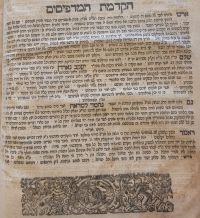
In the printer’s introduction to this copy, Moshe Kashman discusses the work and idea behind this copy. He explains that the Midrash Rabbot had not been printed since the Antonis imprint, and there were no copies left in the city. Someone who wanted to purchase it would have to forgo a hefty sum of gold, and Kashman was approached by many who wanted him to reprint it so that it could be read by all regardless of economic status, implying that the readership of this book is the common Jew. Kashman agreed to reprint the book and expended a lot of labor to compare the disparate preexisting copies and synthesize them to produce the most accurate text possible with added contemporary commentaries. It is difficult to know whether Kashman’s only motivation was to bring this work to the broader public, or if he was also using this narrative as marketing to make people more excited to buy this work.
In his introduction, Kashman writes that while he usually includes a poem in his introductions to his printed works, his wife, “the love of [his] heart, the wise woman who fears God, who possesses all of the positive traits and virtues, Hindle daughter of Rabbi Hirtz”, passed away last winter and he was therefore unable to draft a poem. Instead, he signed with a prayer that God will remove His anger and console the Jewish people.
Materiality
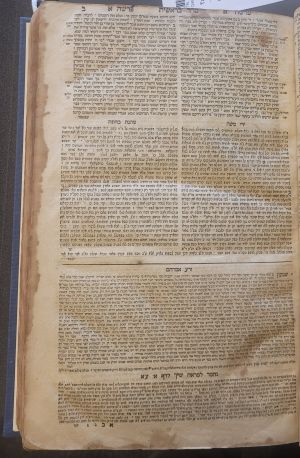
This work is printed on very large folio measuring 35cm across. The paper is very thin and delicate, as evidenced by the few tears in the Kislak copy. From the red staining present on the inside of the Kislak copy, it seems that there was a red fore-edge painting on the book.
The book has 226 pages on 95 leaves, and the pages are numbered 1 1, 1 2, (implied 1 3, implied 1 4), 2 1, 2 2, etc. Additionally, the top corner of every page has a page number to help the reader navigate. The top of the page also has information of which chapter of which book is present and which subsection of that chapter can be found on this page. All of this information is necessary because of the colossal size and contents of this book.
The page contains wide margins which allow room for writing of marginal notes, and references that connect the Midrash to a specific chapter in the Torah are also printed in the margins. Each text on the page ends with the first word on the next page printed in a new line so that the reader can make sure they aren’t missing any pages.
Copy Information
Physical Condition
The binding is much newer than the printing. The flyleaf is a much newer and stronger paper. The binding is bright blue, extremely crisp, and has the name of the title printed in English letters on the outside and the call number, it can be reasonably concluded that it is from the library after 1918. The top is a bit cut off on some pages which also indicates it was rebound. There is red staining and lots of evidence of water damage in this copy, but it is still in very good condition given that it is almost 250 years old.
At the end of the section of the five books of Moses and before the five Megillot, there are some end notes and a poem about the publication. One of the lines asks that just as God helped them to put out the part on the Torah, He should help them to put out the part on the megillot, indicating they might have originally been printed separately and later bound together.
There are underlines and marginalia throughout the book. Some of the marginalia are there to number sections, some to record novellae or origins of unique words, and some of it textual emendations.
Circulation
While in the printer’s introduction, Kashman emphasized that he was printing the work in response to the request of the common Jew, this copy was owned by a socioeconomically advantaged audience.
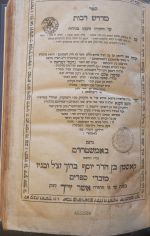
Such a large printed work was probably cost prohibitive, and it is unlikely that this copy was owned by a common Jew close to the time of its printing (although it could have been borrowed by one, but there is no evidence to suggest either way).
Censorship
This copy has three censorship stamps on the two title pages, all very faded and smudged. They contain the insignia of the authority who censored them. The word “cenzura” is present in one of them, indicating that this was done by a Polish censor. Copies of Jewish books at this time were read page by page by the censors to see if they contained any anti-Christian or anti-state sentiment, which would then be removed by the censors. Many Jewish books of this period contain a note at the beginning insisting that all gentiles referenced negatively throughout the work only represent cruel idolators unlike the kind ones of the day, and that laws relating to the monarch refer to times of old unlike the kind and fair monarch of today[8].
Rabbi Zev Wolff Cohen

On the top of the title page, there are two lines of Ashkenazic Jewish script describing the relationship of this book to Rabbi Zev Wolff Cohen. The first line reads
This book of Midrash belongs to (lit. relates to) the Rabbi, the preacher, the master, the well known, our teacher Rabbi Zev Wolff HaCohen.
The second line of text reads
Midrash Rabbot that I purchased for 10 Reichsthaler, the small [one] Zev Wolff Cohen, His rock should guard him and grant him life
It seems that the second line was written by Cohen, and the first line was written later by someone else to show the significance of this book since it was owned by Cohen. Additionally, “Wolff Cohen” is written next to the title in roman characters, seemingly by someone else to indicate that he used to own this copy. Wolff Cohen is like the John Smith of Rabbis, and it is difficult to identify him without definite city or year information, but he was clearly very respected by whomever wrote the first line.
Rabbi Marcus Jastrow
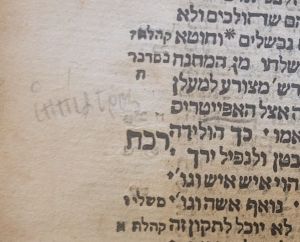
Rabbi Marcus Jastrow was a prominent Rabbi and linguist in Philadelphia in the late 19th century. On the second title page, there is a stamping that reads “LIBRARY OF M. JASTROW.” Jastrow’s most famous work today is his Dictionary of the Targumim, Talmud Babli, Talmud Yerushalmi and Midrashic Literature, which contains English translations and some of the origins of words that appear in Midrash and other works. He would have been very interested in owning this copy of Midrash Rabbot in which the printer describes the lengths he went to in order to ensure accuracy of the text. Additionally, much of the marginalia in the work can likely be attributed to Jastrow and was instructive in his composing his dictionary. For example, one of the entries in his dictionary reads:
אפייטרוס m. (ιππιατρος) veterinary surgeon. Num. R. s. 9.[9]
In this copy, in Numbers Rabbah section 9, the word אפייטרוס is underlined and ιππιατρος is written next to it in pencil. Several other such examples exist throughout the copy.
The Penn Library
Rabbi Marcus Jastrows son, Morris Jastrow Jr., was himself a scholar and a librarian at the University of Pennsylvania. On the second title page it says "5-27-18. Gift of M. Jastrow". Marcus Jastrow died in 1903, so it makes sense to assume that this book was bequeathed to his son after his death. Shortly before Morris' own death in 1921, he donated it to the Penn Library on May 27, 1918. It remains until this day, now housed in the Kislak center for special collections.
Notes
Thank you to Louis Meiselman for deciphering the Wolff Cohen writing.
References
- ↑ A Timeline of the Transmission of the Torah. https://www.chabad.org/library/article_cdo/aid/3127369/jewish/A-Timeline-of-the-Transmission-of-Torah.htm . Accessed 5 May 2024.
- ↑ What Is the Torah?. https://www.chabad.org/library/article_cdo/aid/1426382/jewish/Torah.htm#Is . Accessed 5 May 2024.
- ↑ Midrash Rabbah. https://www.sefaria.org/texts/Midrash/Aggadah/Midrash%20Rabbah . Accessed 5 May 2024.
- ↑ Midrash Rabbah. https://www.myjewishlearning.com/article/midrash-rabbah/ . Accessed 5 May 2024.
- ↑ Teplitsky, Joshua. Prince of the Press : How One Collector Built History’s Most Enduring and Remarkable Jewish Library. Yale University Press, 2019, p. 141.
- ↑ Ibid, Chapter 4, To Make Books without End
- ↑ Ṿanunu, Shimon. Encyclopedia of Rabbinic Sages of Turkey. p. 563 (heb)
- ↑ See, for example, the introduction to Rabbi Yosef Engel's Beit Haotzar (heb)
- ↑ Jastrow, Marcus. A Dictionary of the Targumim, the Talmud Babli, and Yerushalmi, and the Midrashic Literature. G. P. Putnam’s Sons, 1903, p. 103.